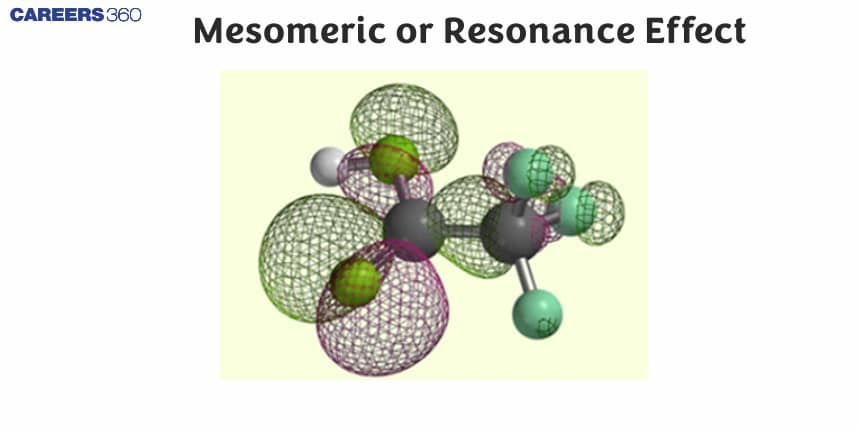Mesomeric or Resonance Effect
The mesomeric effect, also known as the resonance effect, is a key concept in organic chemistry that describes the delocalization of electrons within molecules. This effect is crucial in understanding the stability, reactivity, and electronic distribution in organic compounds.The mesomeric effect is a feature of substituents or functional groups in a molecule. The effect is symbolized by the letter ‘M’ and is used to describe the electron-withdrawing or releasing properties of substituents depending on the relevant resonance structure.

Mesomeric or Resonance Effect
The resonance effect is defined as ‘the polarity produced in the molecule by the interaction of two π-bonds or between a π-bond and lone pair of electrons present on an adjacent atom’. The effect is transmitted through the chain. There are two types of resonance or mesomeric effects designated as R or M effects.
- Positive Resonance Effect (+R effect): In this effect, the transfer of electrons is away from an atom or substituent group attached to the conjugated system. This electron displacement makes certain positions in the molecule of high electron densities. This effect in aniline is shown as:

- Negative Resonance Effect (- R effect): This effect is observed when the transfer of electrons is towards the atom or substituent group attached to the conjugated system. For example, in nitrobenzene this electron displacement can be depicted as:

The atoms or substituent groups, which represent +R or –R electron displacement effects are as follows :
- +R effect: −X,−OH,−OR,−OCOR,−H2,−NHR,−NR2,−NHCOR
- – R effect: −COOH,−CHO,>C=O,−CN,−NO2,−SO3H
The presence of alternate single and double bonds in an open-chain or cyclic system is termed a conjugated system. These systems often show abnormal behavior. The examples are 1,3- butadiene, aniline, and nitrobenzene etc. In such systems, the π-electrons are delocalized and the system develops polarity.
In hyperconjugation, more is the number of $\alpha$-carbons, more is the number of hyperconjugated structures and thus more is the stability. Thus, stability follows the given order:
3o carbocation > 2o carbocation > 1o carbocation
- Mesomeric (Resonance) Effect: The mesomeric effect refers to the delocalization of π-electrons or lone pairs of electrons through conjugated systems within a molecule. It is depicted by drawing resonance structures, which are different possible structures that represent the same molecule.
- Resonance Structures: These are multiple Lewis structures that represent the delocalization of electrons within a molecule. The actual molecule is a hybrid of these structures and has a lower energy than any individual resonance form.
- Positive Mesomeric Effect (+M): Groups or atoms that donate electrons through resonance, increasing electron density on other parts of the molecule. Common +M groups include −OH,−OR,−NH2, and -NHR
- Negative Mesomeric Effect (-M): Groups or atoms that withdraw electrons through resonance, decreasing electron density on other parts of the molecule. Common -M groups include −NO2,−CN,−CO, and −SO2
Recommended topic video on (Mesomeric or Resonance Effect)
Solved Examples Based on Mesomeric or Resonance Effect
Q.1 The order of stability of the following carbocations is:

(1) II>I>I
(2) II>∣I>I
(3) II>II>I
(4) I>II>1II
Solution:
As we have learned
The order of stability of carbocation is -

So, III > I > II
Therefore, option (1) is correct.
Q.2 In the anion HCOO− the two carbon-oxygen bonds are found to be of equal length. What is the reason for it?
(1) Electronic orbitals of carbon atom are hybridised.
(2) The C=C bond is weaker than the C−C bond
(3) The anion HCOO− has two resonating structures.
(4) The anion is obtained by removal of a proton from the acid molecule
Solution:
As we have learned
The two carbon-oxygen bonds are found to be of equal length because of the resonance, both of the carbon-oxygen bonds are of the same length as both bonds attains $\pi$ - bond character due to resonance.
It has two resonating structures.

Therefore, the correct option is (3).
Conclusion
The mesomeric (resonance) effect describes the delocalization of π-electrons or lone pairs within a molecule, contributing to its stability and reactivity. There are two types: positive mesomeric effect (+M), where groups donate electrons (e.g., −OH3,−NH2 ), and negative mesomeric effect (-M), where groups withdraw electrons(e.g., −NO2,−CN) This effect stabilizes molecules, influences reactivity, and affects properties like acidity and basicity.